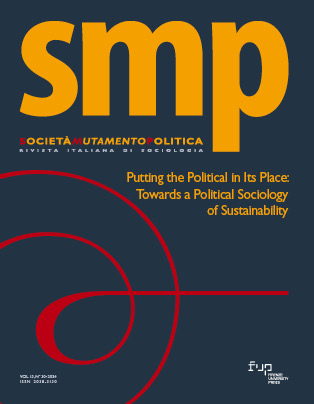Published 2024-12-30
Keywords
- international students mobility,
- media images and narratives,
- autoethnography,
- Italy and Finland,
- cosmopolitan imaginaries
How to Cite
Copyright (c) 2024 Pierluca Birindelli

This work is licensed under a Creative Commons Attribution 4.0 International License.
Abstract
Through analysis of 50 autoethnographies I interpret international students’ imaginaries of Italy-Florence (South Europe), Finland-Helsinki (North Europe) and what can be called “the cosmopolitan elsewhere”. International students’ imaginary of Finland-Helsinki is very slight; that of Italy-Florence is richer and variously articulated: media images and narratives shape students’ expectations before their arrival in the host country. The Finland-Helsinki country profile is instead associated with a vague idea of Northern Europe and often confused with Scandinavia. The respective autoethnographic passages can be synthetically interpreted as past (Italy) vs. present (Finland). On one side Italy-Florence’s image is almost embedded in a cultural past, on the other Finland-Helsinki’s image is almost severed from its history and is seen more as a geographical entity: the deep and mysterious north. Analysis of secondary sources connected with studying abroad reveals the absence of a clear-cut narrative of what it means to be an international student. Nevertheless, there is a glimpse of a vague cosmopolitan narrative. This story, constructed on a global scale by different actors and institutions upholds the generic validity of studying abroad for both instrumental and expressive reasons, and sees it as an institutionalized rite of passage towards global citizenship.
References
- Appiah K. A. (2019), «The importance of Elsewhere: In Defense of Cosmopolitanism», in Foreign Affairs, 28, 2: 20-26.
- Barthes R. (1972 [1957]), Mythologies, Hill and Wang, New York.
- Birindelli P. (2014), The Passage from Youth to Adulthood: Narrative and Cultural Thresholds, University Press of America, Lenham, MA.
- Birindelli P. (2018), «Rites of Passage towards Adulthood and Global Citizenship: Transitions and Liminalities», in Beyond – Studies in International Education, Vol. 1., Pontecorboli, Firenze, pp. 15-45.
- Birindelli P. (2019), «Collective Identity Inside and Out: Particularism Through the Looking Glass», in European Journal of Cultural and Political Sociology, 6, 2: 237-270, https://doi.org/10.1080/23254823.2018.1551146.
- Birindelli P. (2020a), «Cultural Experiences in Florence and Italy: The Grand Tour Narrative in the 21st Century», in Società Mutamento Politica, 10(20): 191-205, https://doi.org/10.13128/smp-11057.
- Birindelli P. (2020b), «The Cultural Experience Abroad: Spotlight, Shadow and Illusion», in Beyond – Studies in International Education, Vol. 3., Pontecorboli, Firenze, pp. 39-62.
- Birindelli P. (2022), Narrative Identity: A Personal Roadmap, Franco Angeli, Milano.
- Birindelli P. (2023), «The Experience of International Students: Biographical Narratives and Identities», in Society, 60(3): 372-387, https://doi.org/10.1007/s12115-023-00809-0.
- Black J. (2010), The British and the Grand Tour, Routledge, London.
- Campbell J. (2008), The Hero with a Thousand Faces New World Library, Joseph Campbell Foundation
- Chaney E. (2014), The Evolution of the Grand Tour, Routledge, London.
- Crouch D., Jackson R. and Thompson F. (Eds. 2005), The Media and the Tourist Imagination: Converging Cultures, Routledge, London.
- Czerska-Shaw K. and Krzaklewska E. (2021), «Uneasy belonging in the Mobility Capsule: Erasmus Mundus Students in the European Higher Education Area», in Mobilities, 17(3): 1-14, https://doi.org/10.1080/17450101.2021.1971053.
- Ellis C. and Bochner A. (2000), «Autoethnography, Personal Narrative, Reflexivity», in N. K. Denzin and Y. S. Lincoln (Eds.), Handbook of Qualitative Research, Sage, Thousand Oaks, CA, pp. 733-768.
- Gaonkar D. P. (2002), «Toward New Imaginaries: An Introduction», in Public Culture, 14 (1): 1-19, https://doi.org/10.1215/08992363-14-1-1
- George S. K. (2010), «The Cosmopolitan Self and the Fetishism of Identity», in S. van Hooft and W. Vandekerckhove (Eds.), Questioning Cosmopolitanism, Springer, Dordrech, pp.63-82.
- Griswold W. (1994), Cultures and Societies in a Changing World, Sage, London.
- Hannam K., Sheller M. and Urry J. (2006), «Editorial: Mobilities, Immobilities and Moorings», in Mobilities, 1(1): 1-22, https://doi.org/10.1080/17450100500489189.
- Hannerz U. (1990), «Cosmopolitans and Locals in World Culture», in Theory, Culture and Society, 7 (2-3): 237-251, https://doi.org/10.1177/026327690007002014.
- Hannerz U. (2005), «Two Faces of Cosmopolitanism: Culture and politics», in Statsvetenskaplig tidskrift, 107(3): 199-213.
- Huang S. (2021), «Be True to Yourself’: Transnational Mobility, Identity, and the Construction of a Mobile Self by Taiwanese Young Adults», in Mobilities, 17(3): 1-16, https://doi.org/10.1080/17450101.2021.1946920.
- Jepperson R. L. (1991), «Institutions, Institutional Effects, and Institutionalization», in W. W. Powell and P. J. Di Maggio (Eds.), The New Institutionalism in Organizational Analysis, University of Chicago Press, Chicago, pp. 143-63.
- Luzzi J. (2002), «Italy without Italians: Literary Origins of a Romantic Myth», in MLN, 117(1): 48-83, https://doi.org/10.1353/mln.2002.0010.
- Nowicka M. (2012), «Cosmopolitans, Spatial Mobility and the Alternative Geographies», in International Review of Social Research, 2 (3): 1-16, https://doi.org/10.1515/irsr-2012-0024.
- Propp V. (2010), Morphology of the Folktale, Vol. 9, University of Texas Press.
- Salazar N. B. (2012), «Tourism imaginaries: A conceptual approach», in Annals of Tourism research, 39(2): 863-882, https://doi.org/10.1016/j.annals.2011.10.004.
- Salazar N. B. (2018), Momentous Mobilities: Anthropological Musings on the Meaning of Travel. Berghahn: New York.
- Salazar N. B. (2020), «On imagination and imaginaries, mobility and immobility: Seeing the forest for the trees», in Culture and Psychology, 26(4): 768-777, https://doi.org/10.1177/1354067X20936927.
- Savage M., Bagnall G. and Longhurst B. (2005), Globalization and Belonging, Sage, London.
- Slotkin R. (1986), «Myth and the Production of History», in S. Bercovitch and J. Myry (Eds.), Ideology and Classic American Literature, Cambridge University Press, Cambridge, pp. 70-90.

